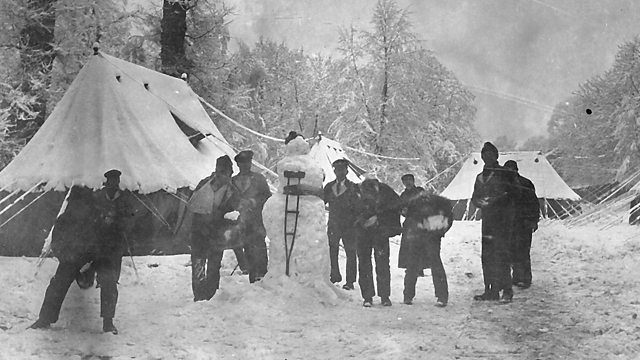New College, Oxford: Understanding Shell Shock
A thunderstorm proves shell shock to be a psychological condition not cowardice
In 1915, William McDougall, Wilde Reader in Mental Philosophy at New College, took charge of the soldiers with shell shock. Soldiers were being sent in increasing numbers to a makeshift hospital encampment in the grounds of New College Oxford. This shanty town of army tents nestled under the medieval walls of the college and was home to more than 100 patients.
In the early years of the war some soldiers who displayed the characteristic symptoms of uncontrollable shaking, paralysis or an inability to speak and walk, were even shot as deserters. Once the symptoms were recognised the debate as to what caused them divided into two camps. Were the causes physical - some kind of poisoning from the shells - or were they psychological?
It was McDougall who proved the psychological basis of the condition. His theory was illustrated by a patient who was making progress but suffered a relapse following a violent thunderstorm in which part of the college wall collapsed on the tents and a corrugated iron roof nearby.
Oxford historian Paul Sullivan tells McDougall's story and Dr Walter Busuttil, director of medical services at Combat Stress (the ex-services mental welfare society) explains why today's sufferers of post-traumatic stress disorder don't exhibit the extreme physical symptoms that the soldiers suffered during the Great War. He details why the ‘physical versus psychological’ debate continues in the light of recent research and why the stigma of the condition still deters some of today’s soldiers from coming forward for help.
If you are affected by any of the symptoms discussed in this story, please contact the Combat Stress helpline: 0800 138 161.
Location: New College, Queens Lane, Oxford OX1 3BN
Photograph of New College Hospital tents courtesy of David Beasley
Presented by Jane Markham, Podcats Productions
Duration:
This clip is from
Featured in...
![]()
�鶹�� Oxford—World War One At Home
Places around Oxford that tell a story of World War One
![]()
Medicine—World War One At Home
Hospitals, medical pioneers and the nursing contribution
More clips from World War One At Home
-
![]()
The loss of HMY Iolaire
Duration: 18:52
-
![]()
Scotland, Slamannan and the Argylls
Duration: 07:55
-
![]()
Scotland Museum of Edinburgh mourning dress
Duration: 06:17
-
![]()
Scotland Montrose 'GI Brides'
Duration: 06:41







